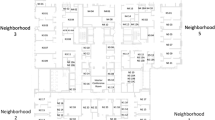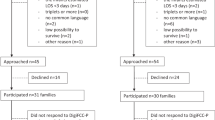Abstract
Background:
Parents whose newborns were cared for in the old neonatal intensive care unit (NICU) environment and then moved to the new NICU environment describe their impressions of the impact upon their infant's care, information access and support, of the two care settings.
Objectives:
To determine the perceptions of parents in the NICU regarding noise, light, space, access to caregivers and personal privacy as they experience both old and new NICU environments in the continuum of care for their infant.
Methods:
In the first 9 months after moving into the new private room NICU, a convenience sampling of parents was voluntarily administered a 20-question Likert scale survey addressing length of stay (LOS) in the respective NICU environment, environmental stimuli, access to caregivers, access to information and personal privacy. Scores reflect frequency of perceptions as never=1, sometimes=2, usually=3 and always=4.
Results:
The responses of 53 parents are reported. This represents 10% of admissions to the private room NICU during the 9-month sampling time. Fifty-nine percent had LOS of ⩽14 days in the old NICU before moving; 76% had LOS ⩽14 days in the new NICU before completing this survey. Median scores for the major content themes are reported (New:Old). Responses suggest that in the new vs old design, parents feel they are able to spend more time with their infant (4:3); have more privacy (4:2) and space for their personal items (4:1); experience less overstimulation with noise and light (1:2); had comparable access to their infant's nurse (4:4) but greater access to their infant's doctor (3:2); and felt comparably informed (4:4) but better supported by the entire team (4:3).
Conclusions:
The new private room NICU is perceived by parents to offer an enhanced environment that is more spacious and less overstimulating for their infant and themselves. Access to professional caregivers, information and overall support appears to be improved in the new environment despite a larger overall NICU area, floor plan and structural layout.
This is a preview of subscription content, access via your institution
Access options
Subscribe to this journal
Receive 12 print issues and online access
$259.00 per year
only $21.58 per issue
Buy this article
- Purchase on Springer Link
- Instant access to full article PDF
Prices may be subject to local taxes which are calculated during checkout
Similar content being viewed by others
References
White RD . Individual rooms in the NICU—an evolving concept. J Perinatol 2003; 23 (Suppl 1): S22–S24.
Brown P, Taquino LT . Designing and delivering neonatal care in single rooms. J Perinat Neonatal Nurs 2001; 15 (1): 68–83.
Floyd AM . Challenging designs of neonatal intensive care units. Crit Care Nurse 2005; 25 (5): 59–66.
Walsh WF, McCullough KL, White RD . Room for improvement: nurses' perceptions of providing care in a single room newborn intensive care setting. Adv Neonatal Care 2006; 6 (5): 261–270.
Carlson B, Walsh S, Wergin T, Schwarzkopf K, Ecklund S . Challenges in design and transition to a private room model in the neonatal intensive care unit. Adv Neonatal Care 2006; 6 (5): 271–280.
Committee on Hospital Care, American Academy of Pediatrics, and Institute for Family-Centered Care. Family-centered care and the pediatrician's role. Pediatrics 2003; 112: 691–696.
Christopher A . A Pattern Language. Oxford University Press: USA, 1977.
Brown W, Pearl LF, Carrasco N . Evolving models of family-centered services in neonatal intensive care. Child Health Care 1991; 20 (1): 50–55.
Author information
Authors and Affiliations
Corresponding author
Rights and permissions
About this article
Cite this article
Carter, B., Carter, A. & Bennett, S. Families' views upon experiencing change in the neonatal intensive care unit environment: from the ‘baby barn’ to the private room. J Perinatol 28, 827–829 (2008). https://doi.org/10.1038/jp.2008.102
Received:
Revised:
Accepted:
Published:
Issue Date:
DOI: https://doi.org/10.1038/jp.2008.102
Keywords
This article is cited by
-
A comparative study of mothers of infants hospitalized in an open ward neonatal intensive care unit and a combined pod and single-family room design
BMC Pediatrics (2020)
-
The business case for building better neonatal intensive care units
Journal of Perinatology (2014)
-
Integrating a sense of coherence into the neonatal environment
BMC Pediatrics (2013)
-
‘Being in a womb’ or ‘playing musical chairs’: the impact of place and space on infant feeding in NICUs
BMC Pregnancy and Childbirth (2013)
-
NICU redesign from open ward to private room: a longitudinal study of parent and staff perceptions
Journal of Perinatology (2013)



